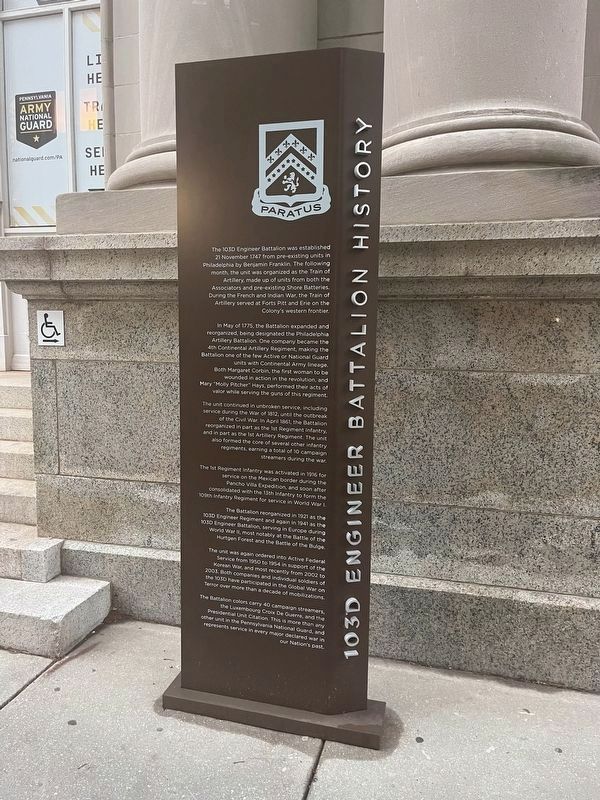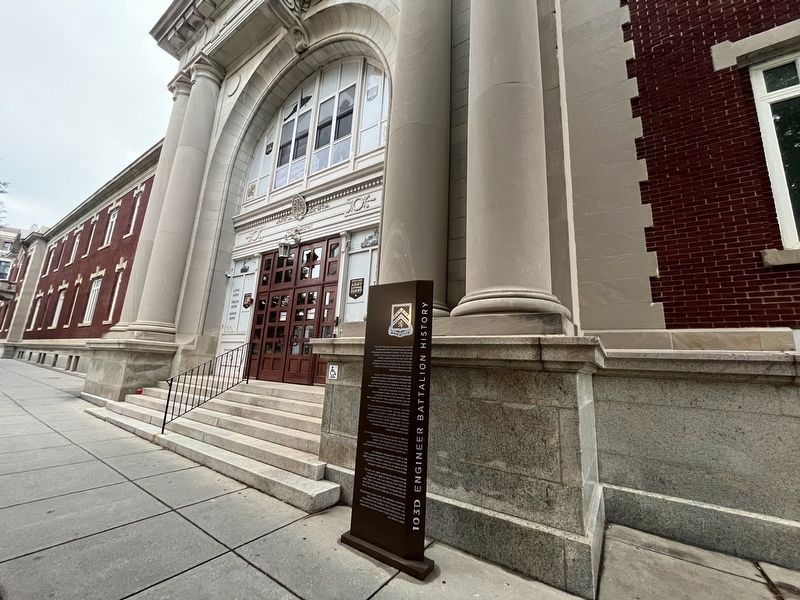University City in Philadelphia in Philadelphia County, Pennsylvania — The American Northeast (Mid-Atlantic)
103D Engineer Battalion History
Paratus
— [Ready] —
The 103D Engineer Battalion was established 21 November 1747 from pre-existing units in Philadelphia by Benjamin Franklin. The following month, the unit was organized as the Train of Artillery, made up of units from both the Associators and pre-existing Shore Batteries. During the French and Indian War, the Train of Artillery served at Fort Pitts and Erie on the Colony's western frontier.
In May of 1775, the Battalion expanded and reorganized, being designated the Philadelphia Artillery Battalion. One company became the 4th Continental Artillery Regiment, making the Battalion one of the few Active or National Guard units with Continental Army lineage. Both Margaret Corbin, the first woman to be wounded in action in the revolution, and Molly "Molly Pitcher" Hays, performed their acts of valor while serving the guns of this regiment.
The unit continued in unbroken service, including service during the War of 1812, until the outbreak of the Civil War. In April 1861, the Battalion reorganized in part as the 1st Regiment Infantry, and in part as the 1st Artillery Regiment. The unit also formed the core of several other infantry regiments, earning a total of 10 campaign streamers during the war.
The 1st Regiment Infantry was activated in 1916 for service on the Mexican border during the Pancho Villa Expedition, and soon after consolidated with the 13th Infantry to form the 109th Infantry Regiment for service in World War I.
The Battalion reorganized in 1921 as the 103D Engineer Regiment and again in 1941 as the 103D Engineer Battalion, serving in Europe during World War II, most notably at the Battle of the Hurtgen Forest and the Battle of the Bulge.
The unit was again ordered into Active Federal Service from 1950 to 1954 in support of the Korean War, and most recently from 2002 to 2003. Both companies and individual soldiers of the 103D have participated in the Global War on Terror over more than a decade of mobilizations.
The Battalion colors carry 40 campaign streamers, the Luxembourg Croix De Guerre, and the Presidential Unit Citation. This is more than any other unit in Pennsylvania National Guard, and represents service in every major declared war in our Nation's past.
Erected by Drexel University.
Topics. This historical marker is listed in these topic lists: Colonial Era • Military • Women. A significant historical month for this entry is April 1861.
Location. 39° 57.368′ N, 75° 11.323′ W. Marker is in Philadelphia, Pennsylvania, in Philadelphia County. It is in University City. Marker is on Lancaster Walk west of North 32nd Street, on the right when traveling
Other nearby markers. At least 8 other markers are within walking distance of this marker. Lancaster Walk (within shouting distance of this marker); Lancaster Avenue Readiness Center (within shouting distance of this marker); Drexel University (within shouting distance of this marker); a different marker also named Drexel University (within shouting distance of this marker); A Tribute to Senior Vice President Anthony T. Caneris and His Wife Antoinette (about 300 feet away, measured in a direct line); Korman Family Quad (about 400 feet away); a different marker also named Korman Family Quad (about 500 feet away); Anthony J. Drexel (about 500 feet away). Touch for a list and map of all markers in Philadelphia.
Credits. This page was last revised on May 22, 2023. It was originally submitted on May 22, 2023, by Devry Becker Jones of Washington, District of Columbia. This page has been viewed 52 times since then and 7 times this year. Photos: 1, 2. submitted on May 22, 2023, by Devry Becker Jones of Washington, District of Columbia.

